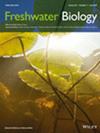Resource Quality and Quantity Exert Distinct Influences on Trophic Interactions and Food Web Pyramids Under Different Nutrient Conditions
IF 2.7
2区 生物学
Q2 ECOLOGY
引用次数: 0
Abstract
- Resource quality and quantity are critical drivers in shaping trophic interactions and food web structures in aquatic ecosystems. However, the lack of clarity on how these drivers distinctly influence energy flow and trophic pyramids represents a significant gap in understanding the mechanisms governing ecosystem stability and productivity.
- This study explored how resource quality and quantity influenced trophic interactions and food web pyramids across a spatial gradient of aqueous nutrient levels. Resource quality was assessed by omega-3 (ω3) long-chain polyunsaturated fatty acids (LC-PUFA), while resource quantity was evaluated based on biomass. Food web components were collected, including algae (phytoplankton and periphyton) and their consumers (zooplankton, macroinvertebrates and fish).
- Our results showed that higher ambient nutrient concentrations significantly boosted phytoplankton biomass, leading to a bottom-heavy biomass pyramid in the low-quality food group. However, this increase in quantity was accompanied by a notable reduction in ω3 LC-PUFA in primary producers, resulting in a distinct FA stock pyramid with a narrowed base and middle. This pattern suggests that despite high phytoplankton biomass, poor food quality created a resource quality bottleneck that constrained the transfer of essential fatty acids.
- This reduction in resource quality simplified the transfer pathways of ω3 LC-PUFA to piscivorous fish, limiting their dietary options and weakening trophic connections. Notably, the unusual role of planktivorous fish in accumulating FA at the second trophic level in the study area, in contrast to typical trends observed in other regions, highlights how variations in species composition and resource quality can reshape trophic structure and influence energy flow.
- Our findings emphasise that declines in resource quality exerted a greater influence on food web dynamics than declines in resource quantity. Our study underscores the importance of considering resource quality, alongside quantity, to maintain ecosystem stability and resilience in nutrient-enriched aquatic systems.
不同营养条件下,资源的质量和数量对营养相互作用和食物网金字塔有不同的影响
资源的质量和数量是形成水生生态系统营养相互作用和食物网结构的关键驱动因素。然而,缺乏对这些驱动因素如何明显影响能量流和营养金字塔的明确认识,在理解控制生态系统稳定性和生产力的机制方面存在重大差距。本研究探讨了资源的质量和数量如何影响营养相互作用和食物网金字塔在水营养水平的空间梯度。以omega-3 (ω3)长链多不饱和脂肪酸(LC-PUFA)评价资源质量,以生物量评价资源量。收集了食物网的组成部分,包括藻类(浮游植物和周围植物)及其消费者(浮游动物、大型无脊椎动物和鱼类)。结果表明,较高的环境营养浓度显著提高了浮游植物的生物量,导致低质量食物组的生物量金字塔底部重。然而,这种数量的增加伴随着初级生产者ω3 LC-PUFA的显着减少,导致明显的FA库存金字塔,底部和中间变窄。这一模式表明,尽管浮游植物生物量高,但食物质量差造成了资源质量瓶颈,限制了必需脂肪酸的转移。这种资源质量的降低简化了ω - 3 LC-PUFA向鱼食性鱼类的转移途径,限制了它们的饮食选择并削弱了营养联系。值得注意的是,与其他地区观察到的典型趋势相比,浮游食性鱼类在研究区域第二级营养水平积累FA方面的不同寻常作用突出了物种组成和资源质量的变化如何重塑营养结构并影响能量流动。我们的研究结果强调,资源质量的下降比资源数量的下降对食物网动态的影响更大。我们的研究强调了在营养丰富的水生系统中,考虑资源质量和数量对于维持生态系统稳定性和恢复力的重要性。
本文章由计算机程序翻译,如有差异,请以英文原文为准。
求助全文
约1分钟内获得全文
求助全文
来源期刊

Freshwater Biology
生物-海洋与淡水生物学
CiteScore
5.90
自引率
3.70%
发文量
162
审稿时长
2 months
期刊介绍:
Freshwater Biology publishes papers on all aspects of the ecology of inland waters, including rivers and lakes, ground waters, flood plains and other freshwater wetlands. We include studies of micro-organisms, algae, macrophytes, invertebrates, fish and other vertebrates, as well as those concerning whole systems and related physical and chemical aspects of the environment, provided that they have clear biological relevance.
Studies may focus at any level in the ecological hierarchy from physiological ecology and animal behaviour, through population dynamics and evolutionary genetics, to community interactions, biogeography and ecosystem functioning. They may also be at any scale: from microhabitat to landscape, and continental to global. Preference is given to research, whether meta-analytical, experimental, theoretical or descriptive, highlighting causal (ecological) mechanisms from which clearly stated hypotheses are derived. Manuscripts with an experimental or conceptual flavour are particularly welcome, as are those or which integrate laboratory and field work, and studies from less well researched areas of the world. Priority is given to submissions that are likely to interest a wide range of readers.
We encourage submission of papers well grounded in ecological theory that deal with issues related to the conservation and management of inland waters. Papers interpreting fundamental research in a way that makes clear its applied, strategic or socio-economic relevance are also welcome.
Review articles (FRESHWATER BIOLOGY REVIEWS) and discussion papers (OPINION) are also invited: these enable authors to publish high-quality material outside the constraints of standard research papers.
 求助内容:
求助内容: 应助结果提醒方式:
应助结果提醒方式:


